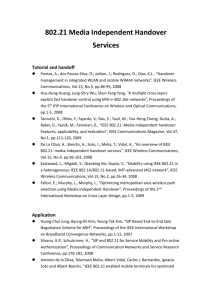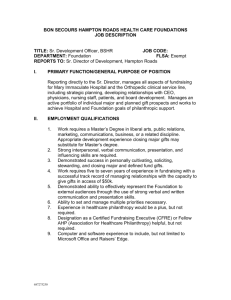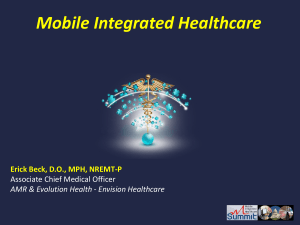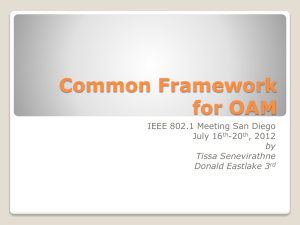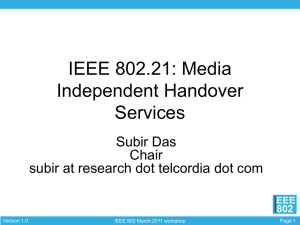21-06-0738-01-0000-802_3Triggers
advertisement
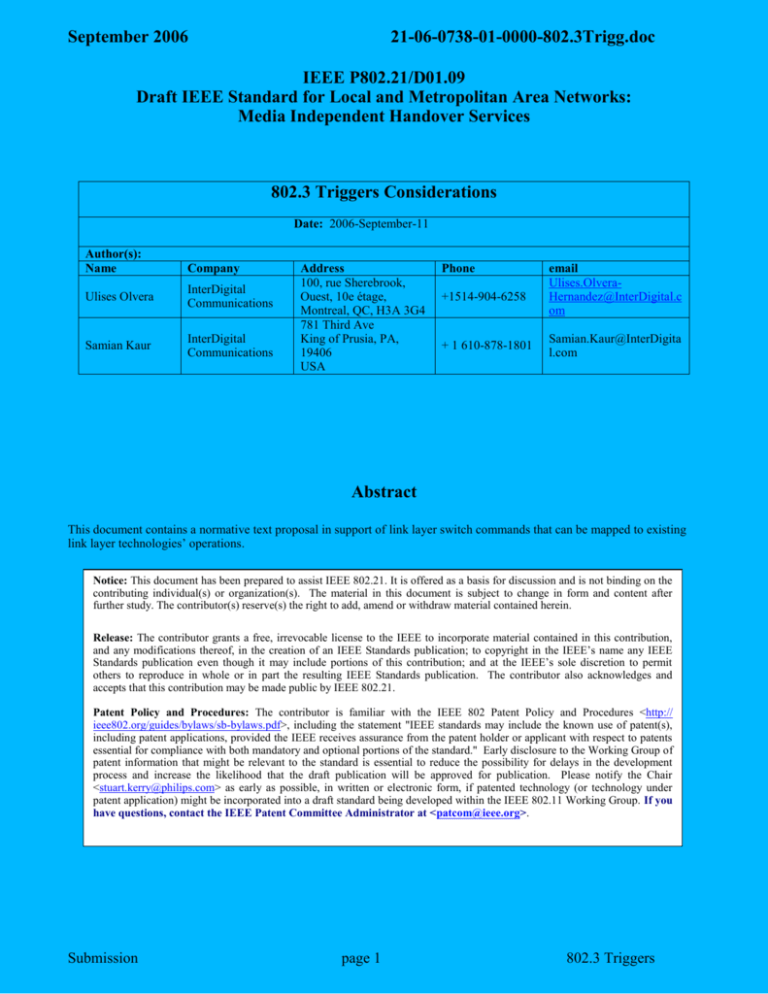
September 2006 21-06-0738-01-0000-802.3Trigg.doc IEEE P802.21/D01.09 Draft IEEE Standard for Local and Metropolitan Area Networks: Media Independent Handover Services 802.3 Triggers Considerations Date: 2006-September-11 Author(s): Name Company Ulises Olvera InterDigital Communications Samian Kaur InterDigital Communications Address 100, rue Sherebrook, Ouest, 10e étage, Montreal, QC, H3A 3G4 781 Third Ave King of Prusia, PA, 19406 USA Phone +1514-904-6258 + 1 610-878-1801 email Ulises.OlveraHernandez@InterDigital.c om Samian.Kaur@InterDigita l.com Abstract This document contains a normative text proposal in support of link layer switch commands that can be mapped to existing link layer technologies’ operations. Notice: This document has been prepared to assist IEEE 802.21. It is offered as a basis for discussion and is not binding on the contributing individual(s) or organization(s). The material in this document is subject to change in form and content after further study. The contributor(s) reserve(s) the right to add, amend or withdraw material contained herein. Release: The contributor grants a free, irrevocable license to the IEEE to incorporate material contained in this contribution, and any modifications thereof, in the creation of an IEEE Standards publication; to copyright in the IEEE’s name any IEEE Standards publication even though it may include portions of this contribution; and at the IEEE’s sole discretion to permit others to reproduce in whole or in part the resulting IEEE Standards publication. The contributor also acknowledges and accepts that this contribution may be made public by IEEE 802.21. Patent Policy and Procedures: The contributor is familiar with the IEEE 802 Patent Policy and Procedures <http:// ieee802.org/guides/bylaws/sb-bylaws.pdf>, including the statement "IEEE standards may include the known use of patent(s), including patent applications, provided the IEEE receives assurance from the patent holder or applicant with respect to patents essential for compliance with both mandatory and optional portions of the standard." Early disclosure to the Working Group of patent information that might be relevant to the standard is essential to reduce the possibility for delays in the development process and increase the likelihood that the draft publication will be approved for publication. Please notify the Chair <stuart.kerry@philips.com> as early as possible, in written or electronic form, if patented technology (or technology under patent application) might be incorporated into a draft standard being developed within the IEEE 802.11 Working Group. If you have questions, contact the IEEE Patent Committee Administrator at <patcom@ieee.org>. Submission page 1 802.3 Triggers September 2006 21-06-0738-01-0000-802.3Trigg.doc Table of Contents 1. 2. 3. 4. 4.1. 4.2. 4.3. 4.4. 5. 5.1. 5.2. 5.3. 5.4 References ............................................................................................................................................ 3 Acronyms and Definitions .................................................................................................................. 3 Introduction ......................................................................................................................................... 3 Using 802.3ah OAM for MIH Event Services ................................................................................... 4 Background ...................................................................................................................................... 4 MIH Reference Model Updated (?) .................................................................................................. 5 Mapping 802.3ah events to 802.21 Event ........................................................................................ 5 Case studies/Scenarios: .................................................................................................................... 6 Using 802.1ag OAM for MIH Event Services ................................................................................... 6 Background ...................................................................................................................................... 8 Reference Model for 802.21 ............................................................................................................. 9 Mapping 802.1ag events to 802.21 events...................................................................................... 10 Case studies/scenarios........................................................................................................................ 11 Submission page 2 802.3 Triggers September 2006 21-06-0738-01-0000-802.3Trigg.doc 1. References 1. 2. 3. 4. 5. IEEE 802.21 Media Independent Handover Services, Joint Harmonized Contribution, July 2005. IEEE 802.3ah-2004 (Amendment to IEEE 802.3) for EFM Operation, Administration and Maintenance. IEEE 802.1ag/D4.1 (August 18, 2005) ITU Y.1730 ITU Q.3/13 2. Acronyms and Definitions CFM MIH OAM PDU PoA PoS SAP SNMP UE VLAN Connectivity Fault Management Media Independent Handover Operations, Administration and Maintenance Packet Data Unit Point of Attachment Point of Service Service Access Points Standard Network Management Protocol User Equipment Virtual Local Area Network 3. Introduction IEEE 802.21 is intended to provide the architecture to enable seamless handover process based on measurements and triggers supplied from link layers. To this purpose, 802.21 defines a set of independent Service Access Points (SAPs): 1. 2. 3. Media Independent Event Service Media Independent Command Service Media Independent Information Service It further provides the definition of additional MAC layer SAPs and associated primitives for each specific access technology. 802.21 MIH EIS require MAC/PHY based event notification for link status updates between the UE and the MIH PoS. MIH EIS events defined include Link Up, Link Down, Link Parameters Change, Link Going Down, L2SDU Transmission Status, Submission page 3 802.3 Triggers September 2006 21-06-0738-01-0000-802.3Trigg.doc Link Event Rollback, Pre trigger (L2 Handoff Imminent), etc. Currently, link layer extensions required to support MIH EIS services are under consideration for the various technologies. For Ethernet networks, link monitoring using continuity messages (like 802.3ah OAMPDUs) is necessitated in multiple scenarios where physical layer signaling is inadequate for detecting peer entities connectivity status. Hence, we propose using 802.3ah and 802.1ag MAC level OAM functions to provide 802.21 Event Information Service in wired and wireless Ethernet access networks. We also show how these events can be mapped to triggers provided by 802.3ah and 802.1ag. 4. Using 802.3ah OAM for MIH Event Services MIH UE UE MIH PoA MIH PoS Hub Hub 802.3 PHY 802.3ah OAM MIH communication Figure 1 UE and MIH PoS separated through Ethernet hubs/repeaters As shown in Figure 1, if the UE and the MIH PoS service are connected through a Hub or Repeater, the Physical Layer signaling at the Layer 1 interface of the UE will be unable to detect the Link Event change between the Hub and the PoS. Hence, the end to end semantics required for handover decision are lost, as loss of connectivity between the hubs is not visible to either the UE or the PoS. It is important to note here that the loss of connectivity beyond the MIH PoS is beyond the scope of what can be accomplished by IEEE 802.21. For this scenario, using 802.3ah protocol allows determining the Link status by making the MIH endpoints OAM peer entities. The MIH entities at the UE and the MIH PoS could use this information to generate Event Notification about Link Status. 4.1. Background The 802.3ah provides an extension to the physical layer link provided by 802.3 to facilitate link monitoring, fault signaling and remote loopback. Link monitoring introduces some basic error definitions for Ethernet so entities can detect failed and degraded connections. Fault signaling provides mechanisms for one entity to signal another that it has detected an error. Remote loopback, which is often used to troubleshoot networks, allows one station to put the other station into a state whereby all inbound traffic is immediately reflected back onto the link. Architecturally, the IEEE 802.3ah EFM specification defines OAM as an optional sublayer just above the Ethernet media access controller (MAC). When OAM is present, two connected OAM sublayers exchange OAM protocol data units (OAMPDUs). As a general rule, OAM uses periodic advertisements to maintain an OAM session and convey information on an Ethernet link. Submission page 4 802.3 Triggers September 2006 21-06-0738-01-0000-802.3Trigg.doc OAM Client (OAM “brains”) MAC Client (Higher Layers) OAM Control OAM sublayerMultiplexer Parser Media Access Control (MAC) Figure 2 OAM Architecture defined under 802.3ah specification 4.2. MIH Reference Model Updated The current MIH Reference Model for 802.3. Layer 3 or higher Mobility Protocol (L3MP), Handover Policy, Transport, Applications 802.21 Scope MIH_SAP Media Independent Handover Layer (MIH) MIH Event Service MIH Command Service MIH Information Service MIH_MAC_SAP LSAP LLC-Logical Link Control or other MAC client MIH_MAC_SAP MAC PHY Figure 3 MIH Reference Model for 802.3 (modified with 802.3ah) 4.3. Mapping 802.3ah events to 802.21 Event Some of the currently defined MIH Events can be associated with existing specified 802.3ah triggers. The 802.3ah framework allows extension of this subset by the vendor using custom TLV specification. MIH Event 802.3ah Triggers Event Description Link Up Submission Link Up page 5 The PHY has determined that the link 802.3 Triggers September 2006 21-06-0738-01-0000-802.3Trigg.doc Link Down Link fault Link Going Down Dying Gasp Link Detected X Link Parameters Change X Link Event Rollback X Link SDU Transmit Success X Link Handoff Imminent X Link Handoff Proceeding X Link Handoff Complete X is up AND the OAM Remote Entity is up. The PHY has determined a fault has occurred in the receive direction of the local DTE An unrecoverable local failure condition has occurred. Table 1 Mapping of 802.3ah triggers to 802.21 events 4.4. Case studies/Scenarios: Figure 4 below describes a handover scenario where link monitoring using mechanism like 802.3ah will become necessary. 802.3ah OAM MIH communication Figure 4 Using 802.3ah 5. Using 802.1ag OAM for MIH Event Services If the UE is connected to the MIH PoS through 802.1D/Q bridged network, Layer 1 PHY event notification or 802.3ah OAM can be inadequate to detect loss of connectivity between the UE and the MIH PoS. There are two possible scenarios:- Submission page 6 802.3 Triggers September 2006 MIH UE 21-06-0738-01-0000-802.3Trigg.doc MIH PoA MIH PoS Mobile Host L2/L3 device Hub Switch 802.3 PHY 802.1 link 802.1ag customer OAM MIH communication Figure 5 MIH entities connected through bridged network 1. If the UE and the MIH PoS are connected through 802.1D bridged network, as shown in Figure 5, physical layer (802.3 level) link status notification are insufficient to detect a link connectivity to the MIH PoS. Also, 802.3 OAM messages do not traverse 802.1 Bridges/switches. 2. If we consider the switches are 802.1Q bridges, as shown in Figure 6, the reachability to MIH PoS could be through different links for different VLANs (either due to static configuration or through configuration of spanning tree running on each bridge). In these scenarios, the MIH connectivity between the UE and the MIH PoS needs to established and monitored on a per VLAN ID basis. Submission page 7 802.3 Triggers September 2006 MIH UE 21-06-0738-01-0000-802.3Trigg.doc MIH PoA MIH PoS VLAN A Mobile Host L2/L3 device Hub 802.1Q Switch VLAN B 802.3 PHY 802.1 link MIH communication 802.1ag customer OAM Figure 6 MIH interconnection through 802.1Q bridged network For these scenarios, we propose the use of 802.1 level link continuity check messages, specifically the 802.1ag protocol for customer level OAM, to detect the end to end link status. 5.1. Background IEEE 802.1ag (also referred to as Connectivity Fault Management) specifies protocols, procedures and managed objects to support transport fault management for end to end Ethernet networks at the customer, operator and service provider levels. These allow discovery and verification of the path, through bridges and LANs, taken for frames addressed to and from specified network users, detection and isolation of connectivity fault to a specific bridge or LAN. CFM mechanisms for fault detection include continuity check, traceroute, loopback (ping), alarm indication, etc. at the different OAM domains, for example at per-service (per VLAN) or per-wire (per PHY) levels, and passes transparently through 802.1Q/802.1ad bridges. Multiple instances of CFM can operate at multiple levels on the same Bridge Port simultaneously. Each Maintenance Domain carries multicast PDUs detected as CFM messages using destination address and EtherType. CFM messages are sourced or received at Maintenance End Points after traversing zero or more Maintenance Intermediate Points. IEEE 802.1ag allows vendor specific TLV extensions and is complementary to 802.3ah, as shown in Figure 7. Submission page 8 802.3 Triggers September 2006 21-06-0738-01-0000-802.3Trigg.doc Figure 7 802.1ag OAM at customer, provider and operator levels If the Bridge is deliberately taken out of commission, then in order to avoid triggering false failure detection, the out-ofcommissioned Bridge indicates its soon to be out-of-state status to other member Bridges for each MA that it participates through a flag in the CCM. The other member Bridges of the service instance, upon receiving this indication, would deactivate the corresponding timer for the heartbeat of that Bridge. Once the Bridge devices have received and processed the CCMs, each Bridge will have a view of all active Bridges for a given customer service instance. A CCM validity timer is used to detect the loss of CCMs. A CCM loss is assumed when the next CCM is not received within the timeout of this validity timer. The number consecutive CCMs are lost before declaring a fault to the remote MEP is configurable MIB object, the default value being set to three. Figure 8 shows the path of CFM messages and triggers in an 802.1 Q/ad bridge, through the additional CFM Up and Down Shim Layers. For details on the configuration and link fault alarms/triggers, refer Clause 17.6 in [3]. Figure 8 "Baggy-pants" model for CFM compliant 802.1 Q/ad bridge It is noted that the current standardization proposal is formulated for Provider Networks using 802.1ad/802.1Q VLAN aware bridges, but future use of the protocol for Ethernet UNIs/end hosts and/or in a network of VLAN unaware bridges has been ratified. Our proposal assumes this extension. 5.2. Reference Model for 802.21 Link SAP diagram here? Submission page 9 802.3 Triggers September 2006 21-06-0738-01-0000-802.3Trigg.doc Higher Layers (Application, Transport, Network) MIH_SAP MIH_SME_SAP Station Management Entity MIH triggers Link status update Handover control MIH_LLC_SAP MIH_MAC_SAP MIH_MAC_SAP MIH_PHY_SAP MIH_PHY_SAP MIH_MGMT_SAP MIH Function 802.2 (LLC) 802.3 802.11 MAC 802.16 MAC 802.11 PHY 802.16 PHY MGMT 5.3. Mapping 802.1ag events to 802.21 events For details on the configuration and link fault alarms/triggers of 802.1ag, refer Clause 17.6 in [3]. MIH Event 802.1ag MIB objects Object Link Up Link Down Link Going Down Dot1agCfmCCheckRestor edEvent Dot1agCfgCCheckLossE vent X Present/ Extension Present Present Extension Description Detected connectivity or connectivity has been restored. A MEP has lost contact with one or more MEPs. A notification (fault alarm) is sent to the management entity with the MEPID of the MEP which detected the problem. Number of CCheck frames that can be lost before indicating fault is dot1agCfmMepCCheckLossFact or. An extension could be to generate “Link Going Down” signal for one (?) less than the count. Link Detected Link Parameters Change X Link Event Rollback X Link SDU Transmit Success X Link Handoff Imminent X Submission page 10 802.3 Triggers September 2006 21-06-0738-01-0000-802.3Trigg.doc Link Handoff Proceeding X Link Handoff Complete X Table 2 Mapping MIH Events to 802.1ag MIB objects 5.4 Case studies/scenarios IEEE 802.1Q VLAN traffic can be carried over native 802.3 and 802.11 frames and 802.16 frames through associated convergence sublayer. Thus, the end to end 802.1ag based connectivity can be valuable to make inter-technology or intratechnology handover decisions. MIH PoS Submission MIH PoA page 11 UE 802.3 Triggers September 2006 21-06-0738-01-0000-802.3Trigg.doc 802.1Q bridge PHY OAM 802.1ag OAM Submission page 12 802.3 Triggers
